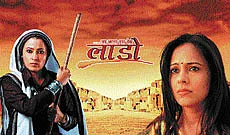

In a palatial house in a village in Rajasthan, a distressed young girl, decked in traditional attire, is arguing with her husband, a medical student in the big city.
The girl has stood first in her higher secondary examination and her success has not gone down well with the husband and his authoritarian grandmother. He accuses her of over-stepping family boundaries. As the entire family looks on shell-shocked, the young girl retorts by saying that she was only completing her studies so that he did not feel ashamed of having an illiterate wife and goes on to relate the benefits of education.
As this high voltage scene from the daily soap, Balika Vadhu, airs on national TV, millions of women across India connect emotionally with the young protagonist and wholeheartedly agree with her. Today, television is an integral part of life the world over. And India is no exception. TV viewing here has become an increasingly routine activity, and while women watch TV for entertainment, at a deeper level, for many it has become a way of coping with life.
Despite the undeniable impact of TV watching, there is little understanding of how it actually influences society. Eight women in Delhi, who had been watching Hindi soaps for the last two to three years, offered interesting insights. Four were from upper class households, and four from poor families.
Many interesting glimpses into contemporary life emerged. Across the two groups, women who worked outside the home watched TV for one to two hours every day, while homemakers tended to watch for at least two hours more on an average. One woman interviewed — a domestic worker — said she regularly saw serials in one of the two homes she worked. Interestingly, while the class hierarchy was kept intact during these viewing sessions — the memsahib sat on the bed, while she sat on the carpet — during the ad breaks, both women discussed the serial almost as equals. For example, while watching Pavitra Rishta, both were delighted that lead pair, Manav and Archana, finally got married after many difficulties. Discussing this, the domestic worker argued that Archana should stop working after marriage and devote more time to the home.
Intriguingly, although a working woman herself, she believed that this was a woman’s central responsibility. As she said this, the upper class housewife nodded in agreement, adding, “Girls these days don’t understand the importance of household work.” In fact, that, unsurprisingly, was also the central theme of Pavitra Rishta.
All respondents revealed they enjoyed watching serials that focused on the lives of women and their families. While they acknowledged that the characters and situations were partly fictional, they argued that the narratives were socially relevant because they had an element of reality in their depiction of interpersonal relationships.
But while viewers from more disadvantaged backgrounds related to the relationships portrayed, they found the opulent backgrounds unrealistic. Others felt that there was no focus on the lives of working women, perhaps because producers believed such portrayals were not “entertaining”. And, one respondent from a Muslim background regretted that Muslim women were rarely shown.
Viewers across the spectrum said that most serials focused on family relationships because they were indeed the most important. One woman put it this way, “I used to work before I got married, but gave up. So if TV depicts this, how is it wrong?”
The portrayal of the female body was another big source of interest to everybody. They noticed that most protagonists were projected as beautiful, fair, thin, with long hair; wearing elaborate clothes, heavy make up and jewellery. They agreed that this pressurised young, and even older, women to adopt the same look.
As for the ‘good’ men, they were expected to provide for the family and protect the vulnerable within and even selectively beyond the household. In contrast, ‘bad’ men indulged in substance abuse and behaved violently with women.
Many respondents believed that the repeated depiction of abusive behaviour resulted in normalising it for viewers. Some even remarked that such abuse was often depicted in a value-neutral manner – the viewer could empathise with the abuser almost as much as with the person being abused. The upper caste Tapasya’s abusive behaviour towards Ichha (the domestic helper’s daughter) in Uttaran, was cited as an example.
Respondents generally approved of the ‘progressive’ outlook of some men in the serials. For example, Veer’s character in Uttaran is very protective of Ichha, the woman he loves. He stands up for her in front of his parents and Tapasya.
These responses indicate an unquestioning acceptance of patriarchy and the general agreement that men and women play differing roles in society, with the woman’s primary duty being to her household. Viewers used their own belief systems to interpret what they saw on TV. For instance, if a woman character leaves her job to take care of a family member or to get married – like Ichha does in Uttaran or Siya in Na Anna..., she is considered virtuous.
The fact that respondents connected the serials to their own lives is significant. For them television was not just a way to pass time, but a platform to make links between the fictitious characters and their real life family and friends. The passionate manner in which all the respondents spoke about their favourite characters underlined this. Television also seemed to help women counter the alienating aspects of modern life. For example, many mentioned that they kept the TV set on whilst doing household chores because it made them feel someone they could relate to was around.
Anandi, Siya, Iccha, Tapasya, Archana… these TV women are part of the daily lives of most India families. Love them, hate them, but one can’t ignore them, at least not in these times.
WFS
